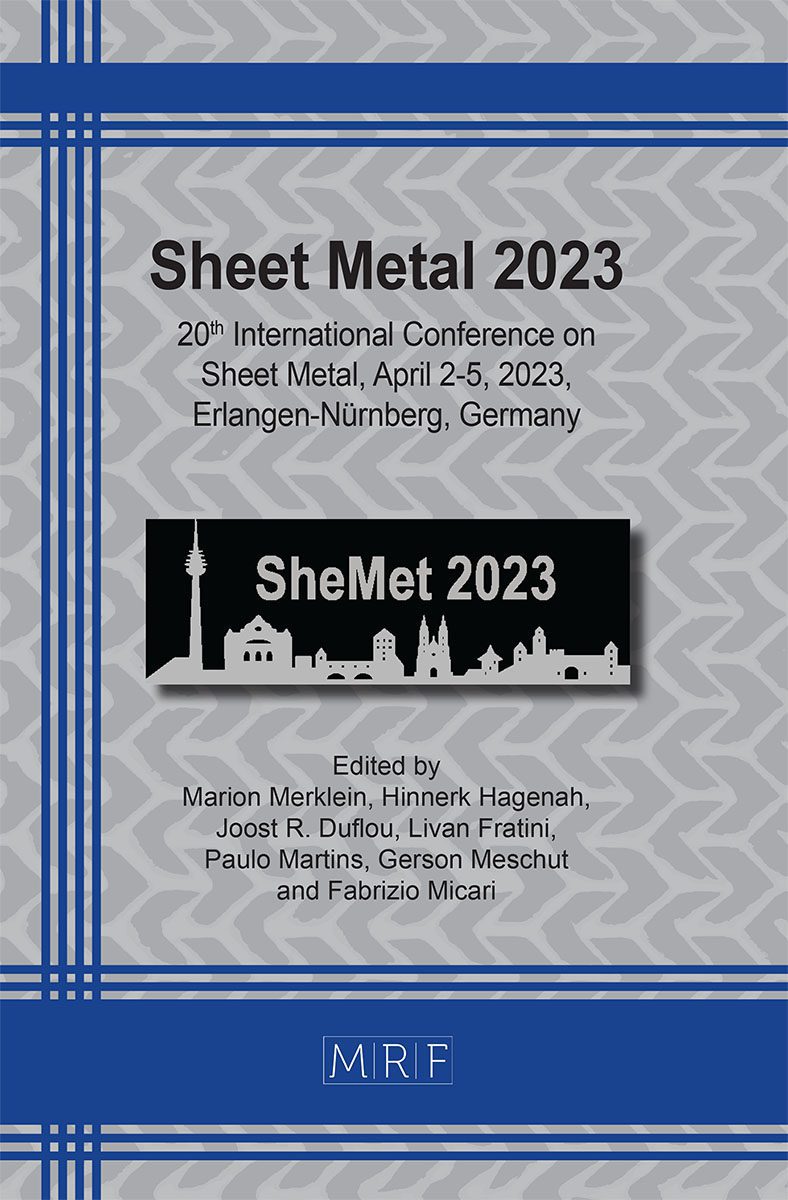Influence of plastic orthotropy on clinching of sheet metal
Johannes Friedlein, Christian Bielak, Max Böhnke, Mathias Bobbert, Gerson Meschut, Julia Mergheim, Paul Steinmann
download PDFAbstract. Clinching is a versatile mechanical joining method for assembling different sheet metal materials without auxiliary elements in short process times. The joint strength, however, solely relies on the material condition and its targeted interlock formation. Therefore, accurate material models are necessary incorporating all relevant phenomena to reliably predict the material behaviour. We extend a finite elastoplastic material model by incorporating the plastic orthotropy of the sheet metal in the joining process simulation. The anisotropy is captured by different variants of the 3D Hill 1948 yield function with associative and non-associative plastic flow. The constitutive models and the 3D clinching simulation are outlined and utilised to study the influence of plastic orthotropy focusing on the aluminium alloy EN AW-6014.
Keywords
Anisotropy, Modelling, Clinching
Published online 3/17/2023, 8 pages
Copyright © 2023 by the author(s)
Published under license by Materials Research Forum LLC., Millersville PA, USA
Citation: Johannes Friedlein, Christian Bielak, Max Böhnke, Mathias Bobbert, Gerson Meschut, Julia Mergheim, Paul Steinmann, Influence of plastic orthotropy on clinching of sheet metal, Materials Research Proceedings, Vol. 25, pp 133-140, 2023
DOI: https://doi.org/10.21741/9781644902417-17
The article was published as article 17 of the book Sheet Metal 2023
![]() Content from this work may be used under the terms of the Creative Commons Attribution 3.0 licence. Any further distribution of this work must maintain attribution to the author(s) and the title of the work, journal citation and DOI.
Content from this work may be used under the terms of the Creative Commons Attribution 3.0 licence. Any further distribution of this work must maintain attribution to the author(s) and the title of the work, journal citation and DOI.
References
[1] M. Jäckel et al., Process-oriented flow curve determination at mechanical joining, Procedia Manufacturing, 47 (2020) 368-374. https://doi.org/10.1016/j.promfg.2020.04.289
[2] M. Böhnke, F. Kappe, M. Bobbert, G. Meschut, Influence of various procedures for the determination of flow curves on the predictive accuracy of numerical simulations for mechanical joining processes, Materials Testing, 63(6) (2021) 493-500. https://doi.org/10.1515/mt-2020-0082
[3] S. Saberi et al., Influence of plastic anisotropy on the mechanical behavior of clinched joint of different coated thin steel sheets. Int. J. Mater. Form. 1(1) (2008) 273-276. https://doi.org/10.1007/s12289-008-0349-9
[4] S. Coppieters et al., Numerical and experimental study of the multi-axial quasi-static strength of clinched connections. Int. J. Mater. Form. 6(4) (2013) 437-451. https://doi.org/10.1007/s12289-012-1097-4
[5] R. Hill, A theory of the yielding and plastic flow of anisotropic metals, Proc. R. Soc. Lond. 193(1033) (1948) 281-297. https://doi.org/10.1098/rspa.1948.0045
[6] A. Breda, S. Coppieters, T. Kuwabara, D. Debruyne, The effect of plastic anisotropy on the calibration of an equivalent model for clinched connections. Thin-Walled Structures, 145 (2019) 106360. https://doi.org/10.1016/j.tws.2019.106360
[7] S. Coppieters et al., Reproducing the experimental pull-out and shear strength of clinched sheet metal connections using FEA. Int. J. Mater. Form. 4(4) (2011) 429-440. https://doi.org/10.1007/s12289-010-1023-6
[8] S. Jónás, M. Tisza, Finite element modelling of clinched joints, Adv. Technol. Mater. 43(1) (2018) 1-6. https://doi.org/10.24867/ATM-2018-1-001
[9] J. Friedlein et al., Inverse parameter identification of an anisotropic plasticity model for sheet metal. In IOP Conference Series: Mater. Sci. Eng. 1157(1) (2021) 012004. https://doi.org/10.1088/1757-899X/1157/1/012004
[10] C.R. Bielak, M. Böhnke, M. Bobbert, G. Meschut, Numerical investigation of a friction test to determine the friction coefficients for the clinching process. Proc. Inst. Mech. Eng. L: Journal of Materials: Design and Applications, 14644207221093468 (2022).
[11] C. Miehe, N. Apel, M. Lambrecht, Anisotropic additive plasticity in the logarithmic strain space: Modular kinematic formulation and implementation based on incremental minimization principles for standard materials, Comput. Methods Appl. Mech. Engrg. 191(47-48) (2002) 5383–5425. https://doi.org/10.1177/14644207221093468
[12] T.B. Stoughton, A non-associated flow rule for sheet metal forming. Int. J. Plast. 18(5-6) (2002) 687-714. https://doi.org/10.1016/S0749-6419(01)00053-5
[13] J.C. Simo, T.J.R. Hughes, Computational inelasticity, 7, Springer Science & Business Media, 2006.
[14] A.M. Habraken, Modelling the plastic anisotropy of metals. Arch. Comput. Methods Eng. 11(1) (2004) 3-96. https://doi.org/10.1007/BF02736210
[15] O. Ghorbel et al., Coupled anisotropic plasticity-ductile damage: Modeling, experimental verification, and application to sheet metal forming simulation. Int. J. Mech. Sci. 150 (2019) 548-560. https://doi.org/10.1016/j.ijmecsci.2018.10.044
[16] P. Dasappa, K. Inal, R. Mishra, The effects of anisotropic yield functions and their material parameters on prediction of forming limit diagrams. Int. J. Solids. Struct. 49(25) (2012) 3528-3550. https://doi.org/10.1016/j.ijsolstr.2012.04.021































